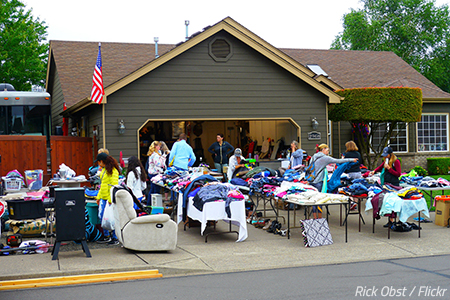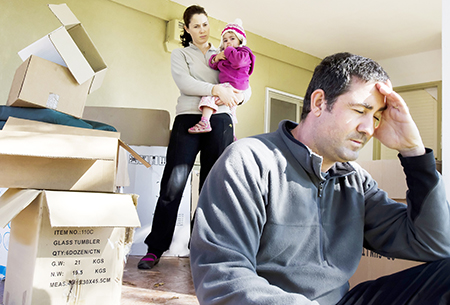Moving across the country is an expensive affair.
 The average cost of an interstate move is around $4,300 (according to the American Moving and Storage Association), so it’s hardly surprising that most people are looking for cheap ways to move across country. The cheaper, the better, of course.
The average cost of an interstate move is around $4,300 (according to the American Moving and Storage Association), so it’s hardly surprising that most people are looking for cheap ways to move across country. The cheaper, the better, of course.
When you’re getting ready to move to another part of the country, you too should make an effort to save as much money as possible on your long-distance move. After all, money doesn’t grow on trees.
Here are the top 10 ways to pay less when moving across the country.
1. DO NOT PAY for expensive moving services
One of the best ways to move cross country cheaply is to hire the services of an affordable cross-country moving company. Now, while that initial moving-on-a-budget advice is a classic example of an easier-said-than-done case, finding cheap moving services is still quite possible if you know where to look and what to look out for.
Keep in mind that moving across the country is not the right time to be thinking about organizing a self-move. The greater relocation distance and the bigger DIY relocation risks are clear signs that you should be thinking about hiring the services of a professional mover. An AFFORDABLE mover, at that.
Do not pay for overpriced relocation services!
Professional moving companies charge differently for the same services, so the only logical way of picking that one cost-effective mover out of the pack is to follow these simple 7 steps.
- Step1: Get in touch with 4-5 reputable long distance moving companies in your area;
- Step 2: Request in-home inspections from those relocation experts;
- Step 3: Have your household items examined and possible moving day problems and risks assessed by the professionals;
- Step 4: Get accurate moving quotes that best reflect the final price you’ll pay;
- Step 5: Compare the moving cost estimates you receive and pick the most cost-effective relocation offer;
- Step 6: Use your common sense to detect any early signs of moving fraud – in that case, a moving quote that is way lower than the rest (aka a low-ball estimate);
- Step 7: Book the services of the moving company that’s offered the best price, services, and conditions.
How to find cheap movers: 7 simple steps
2. DO NOT assume you can’t negotiate with your mover
Luckily, there are more than one ways to cut moving costs so that you end up paying as little as possible for your cross-country move.
How about using your negotiation skills to pay less money on your long-distance move? That’s right – you can and you should negotiate with your movers for a lower price simply because you’ve got nothing to lose. Ultimately, the worst that can happen is to get them to say NO, in which case you’ll pay the original quoted price.
How do you negotiate with movers?
One negotiation trick you can use is to contact the moving company that you think will be ideal for the job and tell them that you’d like to use their services but one of their competitors has offered you a better deal. The main idea here is to get them to price-match or even bear the lowest quote you got from various cross-country movers. If the mover you’ve contacted is serious about securing you as their customer, they should try to offer you a better deal than they did originally.
If the moving company is not willing to lower the price they have quoted you, then ask them if they happen to have any ongoing discounts or promotional offers you can take advantage of as a first-time customer. It never hurts to ask – besides, you may get pleasantly surprised by the response of the said mover.
3. DO NOT PAY for moving any items you won’t need

Organizing a garage sale is a good way to get rid of unwanted items and thus lower your moving costs.
Moving across country inexpensively is possible if you move only the things you like and will use in the foreseeable future.
The truth is that as long as you understand how the price of a long-distance move is calculated (the total shipment weight is a major price-forming factor), you will want to declutter your home and then get rid of all the items that are clearly not worth the transportation costs.
Ask yourself this: why should you PAY to move some of your belongings only to place them in storage as soon as you arrive in your new home? That’s right – you shouldn’t. In reality, moving with fewer items will enable you to save
- MONEY – fewer packing materials, reduced transportation charges;
- TIME – faster packing and unpacking, reduced loading and unloading time;
- SPACE – more cargo space available in the moving vehicle, less storage space taken in the new home.
Moving cross country on a budget is all about making the right choices when it comes to keeping more money in your wallet. And the best thing about choosing to get rid of unwanted items prior to move-out day is that you can actually earn some cash by selling the things that still have any commercial value.
The home decluttering tactic before moving is simple, and it works great too!
- Step 1. Inventory your entire home;
- Step 2. Set aside the items you won’t be moving to the new residence;
- Step 3. Attempt to sell, either online or at a garage sale, all those unwanted items;
- Step 4. Donate to charity or give away to friends the items you could not sell;
- Step 5. Throw away for recycling all the things nobody will ever need again.
How to get rid of unwanted items when moving
4. DO NOT TAKE it that your friends won’t give you a hand
When moving on a tight budget, one of the best ways to deal with the difficult situation of having to move house with as little money as possible is to rely on your friends to help you pack and move your heavy stuff.
The idea here is simple: it’s expensive to pay for professional packing services, so you might as well arrange for non-professional packers to give you a hand. As you can imagine, asking your friends to help you out will enable you to save money when moving across the country but the friendly option will come with a price as well.
Your friends won’t charge you for helping you out, of course, but they will expect you to return the favor one day. (A promise is a promise, right?) Also, your pals will appreciate it if you view the whole gathering as a packing party – meaning that they will expect some food, drinks, and even good music to stay entertained while they’re working by your side.
Ideally, you will keep the overall moving costs down by having enough time to pack up your things by yourself.
5. DO NOT PAY for professional packing services
When looking for cheap ways to move across the country, you should definitely do your best to reduce your moving costs any way you can. Selecting a low-cost mover and moving only the things you’ll really need are two excellent ways to save on your long-distance move.
However, oftentimes you’ll need more than those two cost-saving tips when moving cross country to be able to define your own move as successful.
When getting ready to move out, you shouldn’t be too eager to spend your hard-earned money on anything that you may easily do without. One great example is to choose to pay for professional packers when you can finish that task by yourself, or almost by yourself.
Save good money when moving across country by packing all your belongings without requesting professional packing. Provided that you have enough time to complete the packing job en route, you can easily pack up your shoes, clothes, bedding, and other soft goods. Also, you should be able to pack most non-breakable items such as books without any considerable problems.
IMPORTANT: Packing your things on your own will reduce your moving costs unless you happen to own a number of special (valuable and/or fragile) items in your home that do require professional packing services. In most cases, you’re advised to hire professionals to pack and move your antique furniture pieces, your grandfather clock, your piano, your pool table, or your hot tub.
Packing checklist: Packing timeline for moving
6. DO NOT PAY for costly moving boxes

Enough time and a bit of effort is all you need to find free cardboard boxes.
Whether you realize it or not, the cost of packing materials can burden your moving budget more than it’s necessary. Statistically speaking, an average house move requires around 60 packing boxes of various sizes.
Add to that substantial packing expense the cost of packing paper, bubble wrap, tape, etc., and you’ll soon start wishing you could somehow find a way NOT to pay for those packing supplies.
The good news is that, as long as you have sufficient time, you should be able to find most of the packing materials without paying for them. Cardboard boxes will be your biggest expense and you’ve got a few good choices of scoring moving boxes for free:
- Ask friends, neighbors, and work colleagues if they have any cardboard boxes they won’t ever need again;
- Visit specialized websites such as Craigslist or Freecycle to check whether someone in your area offers packing boxes for free;
- Take a quick tour around local businesses such as large supermarkets, shopping centers, home electronics stores, bookstores, and even liquor stores. Speak with the store managers and ask them if you can have some of their surplus cardboard boxes at no cost for you. At the end of the day, most stores are required to recycle their cardboard, so you’ll probably end up with more cardboard boxes than you can handle.
Also, if you really need to take your cost-saving efforts to another level, it’s useful to know that second-hand packing paper and bubble wrap can be obtained for free from friends, neighbors, and coworkers, or online.
Where to find free moving boxes
7. DO NOT PAY for overpriced packing materials either
Getting moving boxes for free is an excellent opportunity to lower your moving expenses and move house for less money. Nevertheless, the rest of the packing supplies you’ll need to get the job done will also cost you money, sometimes much more than you are willing to spend anyway.
Interestingly enough, a great share of all the required packing materials you can find at… your own home. 100% free of charge!
So, here’s one cost-saving trick of not paying for boxes, bubble wrap, packing paper, and furniture blankets when moving long distance across the country.
- Buckets, baskets, laundry hampers. If you’re taking some of the plastic buckets, baskets, and laundry hampers you have in your home, why don’t you fill them up with pieces of clothing, shoes, bedding, children’s toys, or any non-fragile items that will fit inside them?
- Suitcases. Suitcases are great for transporting clothes, of course. However, if you have wheeled suitcases, then a good idea is to use those for packing and moving books. Remember – books are super heavy when packed together!
- Drawers. You wouldn’t normally think of furniture drawers as moving containers but that’s exactly what they are. Wrap drawers in stretch wrap so that their contents stay intact inside them.
- Bags. Bags are the grossly underrated moving containers and you’d do great to use their versatility – strong shopping bags, clean trash bags, vacuum bags, and resealable Ziploc bags.
- Blankets. Whenever you need to protect delicate items, use the ordinary household blankets in your home as the substitute for the costly furniture blankets.
- Bed sheets. Use old bed sheets as cushioning materials when packing breakable items for moving.
- Towels. Because of their thickness and softness, bath towels are great for protecting fragile items during the move. In some cases, towels can provide better protection even than bubble wrap.
- Socks. You can use thick socks to protect breakable items, especially stemware glasses. Make sure the socks are clean too.
- Newspapers. Newsprint costs practically nothing when the newspapers have already been read. Use newsprint as a good alternative to packing paper but be careful as newspapers tend to leave bad ink stains on delicate surfaces. Never use newsprint as the first layer of protection!
15 great packing tips for your move
8. DO NOT PAY the price of lost time
You know that time is money, don’t you?

Time management is crucial when getting ready to move across the country.
When you’re preparing for a cross-country move, you’ll soon realize just how precious TIME is, especially when Moving day is just a few days or so away. In fact, one of the worst-case scenarios when moving cross country is to fail to finish your pre-move preparations on time and to have your movers knocking at the door before you’re 100% ready for the move.
In reality, running out of time when getting ready to move across country means that you’ll be forced to hire extra packing and/or moving labor to compensate for the lost time. And that, mind you, will cost you more money in the end.
Whoever said that TIME is MONEY must have been right all along, right? So, it’s TIME to save MONEY by organizing TIME in the best possible way. And that way comes in the form of a moving checklist.
A moving checklist is a detailed to-do list of move-related tasks that will help you plan meticulously and use efficiently the time you’ve got until the day of the move, regardless of whether that time is a few months, one month, a couple of weeks, or just a few days.
The best thing about having a checklist for moving across country is that you won’t make the mistake of failing to do an important task. The highly customized and prioritized to-do list will guide you throughout the move and keep you greatly motivated as you keep marking those jobs as DONE.
Creating a moving checklist is easy too – you just write down on a piece of paper all the things you have to do prior to moving away. Should you ever need some good ideas about what to do when moving house, feel free to use our moving checklist as a good source for ideas and motivation.
MOVING CHECKLIST: interactive & printable
9. DO NOT PAY for costly moving mistakes
While you’re looking for various cheap ways to move across country, as you should, one thing you should always keep in mind is that some packing and moving mistakes may turn out to be too costly in the end.
It’s nearly impossible to have a completely error-free move, but you should at least try to minimize those moving mistakes in an attempt to keep your own relocation expenses in control.
Here are 3 costly moving mistakes you should avoid at all costs:
- On-site inspection. Some interstate moving companies give you cost estimates over the phone or via e-mail without visiting your home in person. You accept such a quote, then the respective mover wants much more money than they quoted originally. As a result, you lose MONEY.
- Research. You hire the services of an interstate mover without doing any research about the company. The moving company proves to be a dishonest one and holds your household items hostage until you pay extra money to get back your stuff. As a result, you lose MONEY.
- Valuables. You hire professional movers, then on the day of the move you entrust your most valuable items – jewelry pieces, family heirlooms, electronic gadgets, important documents, irreplaceable items – to those strangers.
Never do this, as you could lose plenty of MONEY and not see those valuables again. Remember: it’s your responsibility to move any valuables that are small enough to fit into your personal vehicle.
33 moving mistakes to avoid on your next move
10. DO NOT EVER GET scammed by dishonest movers

May this never happen to you.
One of the worst-case scenarios when moving to a new house is to deal with dishonest movers that will try to rip you off any way they can. Needless to say, you must do all in your power to stay away from the so-called rogue movers.
It’s your prized possessions and your hard-earned money, so here’s how to make sure the moving company you hire will be 100% legitimate – that is, properly licensed by the U.S. Department of Transportation:
- Avoid getting estimates via email or over the phone because those quotes can never be accurate.
- Request in-house surveys from the interstate movers where they will have the chance to actually see what you have for moving and give you a much more accurate quote as a result. If a moving company refuses to visit your home in person, then just scratch it out from your shortlisted candidates.
- Research the movers that have given you estimates. All state-to-state moving companies must be registered with the Department of Transportation and have valid DOT numbers as proof. Visit this page to check the DOT number of each cross-country mover.










Wonderful blog and very good ideas are mentioned here. Want more bogs like this.